Inventions Competition 2019: Drills and cultivators on a budget
This year’s Farmers Weekly Inventions Competition yielded another fine crop of farm-fettled steelwork. Drills, cultivators and fertiliser applicators feature in this arable-focused round-up.
See also: Serial inventors reveal their home-made farm kit
Stephen McGuffie’s poly winding machine – complex category winner
This year’s complex category top prize goes to fruit and veg grower Stephen McGuffie for his cleverly designed and beautifully built polythene winding tool.
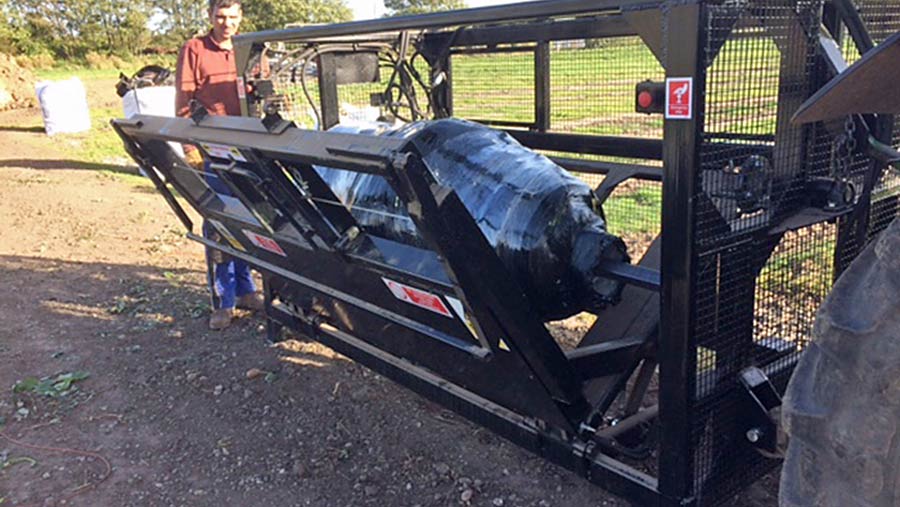
The one-off machine was made to wind up plastic and rope used to cover tunnel structures over crops of berries, cherries and asparagus and is powered by an intricate electric-over-hydraulic system.
In operation, a rotating spool is used to draw the materials in, the speed of which can be controlled by the operator.
To help make sure distribution is even along the spool there’s also a sliding aperture, which can be moved from side to side during the winding process.
When it comes to unloading a full spool, the operator simply opens the access doors and releases the spool shaft clamps. A hydraulically actuated cradle is then used to lift the spool off the drive shaft and eject it onto the ground.
The key reason for using an electric-over-hydraulic system is the safety measures it offers. By taking a 12V supply from the tractor and running it through a relay control, Mr McGuffie has been able to introduce several cut-outs for the hydraulics.
These include two emergency stop buttons, a trip bar close to the poly in-feed, cam switches on the access doors and a manual reset button.
If any of the safety devices are triggered, the machine will stop instantly and it can’t be restarted until the operator presses the manual reset button.
Mr McGuffie built the winder for the family business, New Farm Produce, based in Staffordshire and it took about 18 months to complete.
All in, the cost of materials came to between £5,500 and £6,000. At the request of the HSE he also went through the process of getting it CE marked.
Rob and Dave Gash’s strip-till drill – complex category third place
Regular Inventions Comp contributors Rob and Dave Gash tool the bronze medal in the complex category with their strip-till drill for getting oilseed rape into the ground.
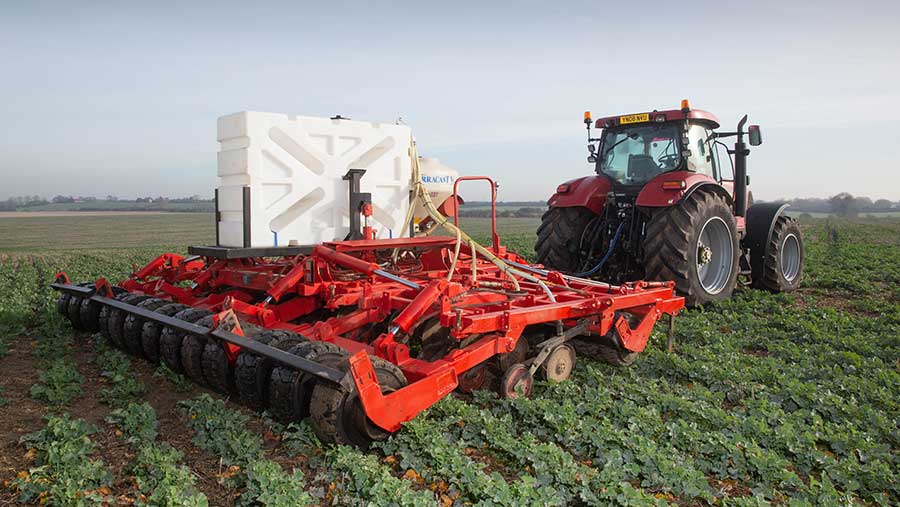
Their first OSR seeder used a combination of subsoiler legs and Horsch Pronto disc coulters to get the seed in the ground, but they found it brought too many clods to the surface in unfavourable conditions.
Its replacement is based on the rock-solid frame of a Simba Free Flow, now renowned as the go-to donor drill for anyone looking to self-build.
Having sourced a relatively smart version for £3,500 from a local dealer, the brothers stripped off most of the working parts – tines, markers, tank and alike – which they sold for £2,000.
The new layout sees a row of low-disturbance, home-made legs run at the front to cut a slot for the following coulter. They’re made out of lengths of 10mm-thick bucket blade and are fitted at 47cm intervals (13 in total) on the original mountings, working roughly 5-6in deep.
The first set managed 100ha, so the brothers are toying with the idea of using ferobide tile tips to extend their working life. That said, at £8/leg, replacements aren’t bank-breaking.
A packer roller works ahead of the Horsch Pronto disc coulters, which were sourced from Weaving Machinery and given a quick refurb prior to fitting.
A second packer at the back of the drill apparently does such a good pressing job that there’s no need to follow with the rolls.
The rig carries a 1,250-litre fertiliser tank running on a little electric pump with manual regulator. However, with the laden weight touching 7t, the farm’s Case Puma has to work pretty hard to pull it on the stiffer ground.
Total build cost was about £7,000, including labour, and Rob says it worked a treat in last year’s hard, dry conditions.
Ben Lount’s wild bird seed drill
Ben Lount wanted a simple way to accurately place fertiliser in a 3m band on wild bird seed cover around field boundaries to to perk them up during spring.
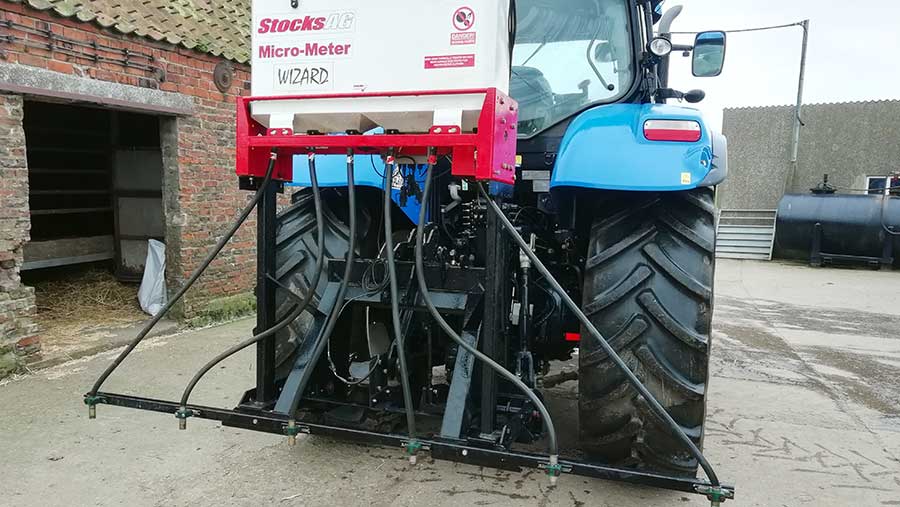
He took a redundant Maschio power harrow and used the headstock as the base to mount a 120-litre Stocks Micrometer seeding unit.
The Micrometer (which was already on the farm for drilling oilseed rape with a Sumo Trio) is equipped with radar electronic metering and can still be bolted onto the drill in the summer to apply fertiliser.
The fert trickles down six tubes and plates at the bottom spread it over the full width.
All in, the fertiliser toolbar took about two days to complete and has been in use for two years with successful results. It cost virtually nothing to build, as everything was on the farm already.
Ian Mellor’s oilseed rape drill
In a bid to get away from using the farm’s Amazone Combi drill to get oilseed established, Ian Mellor from near Barnsley, South Yorkshire, developed his own subsoiler-based system that has helped to reduce seed rates and give the crops space to branch out.

He started with an old Spaldings Flatlift and initially stuck with the three-leg setup to check that the concept was worth pursuing. Initial impressions were good, so he welded another two legs to the frame to fill the gaps between the existing three.
The Flatlift’s roller stayed on the back and he mounted two gravity-fed Weaving hoppers and metering systems from Weaving above it.
Oilseed rape seed runs from the rear hopper to the coulters, while the front one carries slug pellets that hit splash plates at the end of the tube. This means they are pretty evenly dispersed across the ground.
The five coulters are manually adjusted for depth controlled via a tightener spring, with five slots on the following packer wheels depending on how tight Mr Mellor feels the slot needs to be.
An old Hardi mounted sprayer was kept when the farm recently upgraded to a Kellands Agribuggy and the front 600-litre tank has now found a new home adding fertiliser with the new drill.
Its pipework runs through the chassis of the 2018 John Deere 6155R to the-rear mounted bracket and pressure gauge. Five pipes then ferry the fertiliser with specially made holders that sit just behind each leg.
So far, the drill has completed just shy of 56ha and has worked well. Mr Mellor reckons he has spent about £3,000 in total, with £900 of that going on new subsoiler legs and the Weaving tanks.
Richard Warren’s grassland drill
For less than £500, Richard Warren adapted an old 4m MF 30 drill so he could overseed tired, worn-out grassland on land he rents for grazing in Dorset.
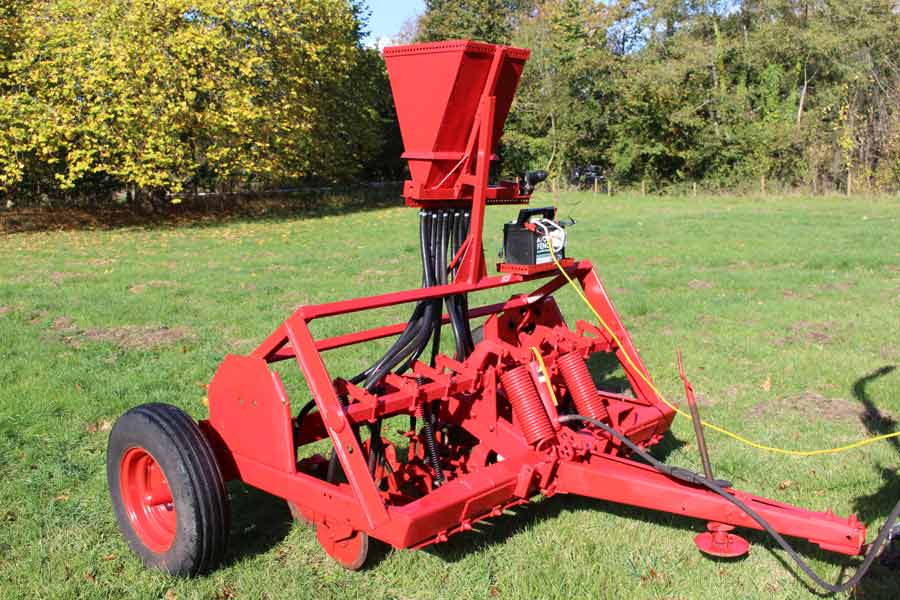
He began by lopping off sections in the middle and rewelding the ends back on. He retained the old independent coulter arms, but ditched the boot-type arrangement behind the disc as it opened the slot too wide, fitting an adapted slimmer version in its place.
The drill now runs 10 coulters (down from the original 15) and the discs needed a bit of love with the angle grinder to bring them back into a useable condition.
The hopper is an old garden fertiliser spinner from B&Q, into which Mr Warren drilled a few more holes to increase seed flow.
It’s powered by an electric window motor from a Honda HRV running from a 12V deep-cycle electric fence battery, with crocodile clips to attach the wires from the 40hp Land Legend tractor on the front.
Charlie Beattie’s tractor weight frame
Regular inventor Charlie Beattie from Loanhead Farm in Perthshire combined a weight frame and storage boxes with a Murray stone fork to make a quick and easy way of collecting rocks in fields.
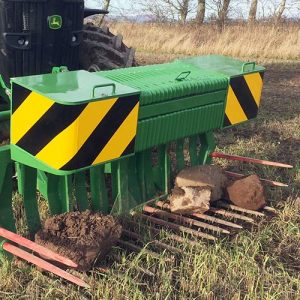
The assembly fits to the front of the farm’s John Deere 7R and means he can pick up stones while bed-tilling the farm’s 250ha of potato land, and also carry a full set of blades for the Scanstone tiller.
The stone fork was bought new with a ready-made plate to take the 7R’s base weight.
He added 24 JD wafer weights and knocked together a pair of boxes from 10mm sheet steel to sit each side.
Two 16mm threaded rods and a section of 75x50mm box join the storage containers together, and they’ve been given padlock-lockable lids and a rubber seal from a scrapped car windscreen to keep them thief-proof and watertight.
A local paint shop then sprayed it JD green and added reflective chevron stickers.
The two-day job cost about £800.
Simon Walter’s hybrid cultivator
Hayling Island farmer Simon Walter has developed an upgraded version of his hybrid cultivator that he uses to bash his clay soils into submission and bury the abundant trash and annually applied compost.

The new 3m-wide model has a reduced number of mid-depth (200mm) Lemken legs – down from seven to five – which makes it less liable to block in heavy trash conditions.
There are a further two subsoiler legs than run in line with the tractor wheels at 350mm deep to remove any compaction.
Mr Walter has actually developed two versions of the same machine – one runs a power-harrow on the back, while the second has a rotavator attachment.

Both work to stir in the straw and leave a flat, fine-tilthed layer on top ready for seeding, but the rotavator has the advantage of its direction of motion (over the top, rather than round and round) to help propel the rig forwards.
Piggybacking a pto-powered implement on the shear bolt-protected legs also allows him to make the most of the New Holland tractor’s boost function.
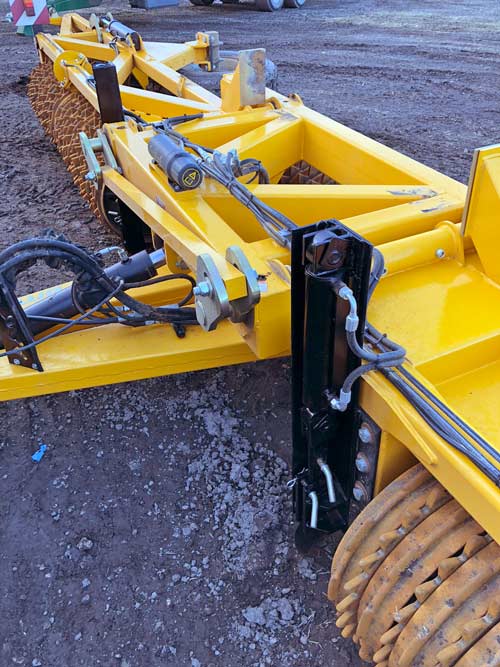
Tom Storr’s pre-emergence markers
Farmworker Tom Storr from Lincolnshire assembled a neat set of bolt-on pre-emergence markers to fit the farm’s set of 12m Twose rolls.
Hydraulic rams from an old brick grab picked up at a farm sale move the markers in and out of work.
These are fed by new hydraulic pipes – the only non-recycled component of the build.
Adjustable pins alter the depth of the markers to suit different soil types and the whole lot simply bolts to the frame of the rolls.
A black paint job finished things off.
Hadyn Esp’s tillage train
To work his 40ha of arable land before a local contractor comes in to drill, Shropshire farmer Hadyn Esp assembled his own one-pass tillage train.
At the front of the rig he used a traditional C-tine cultivator and mounted a crumbler roller on the back.
He then fabricated a three-point linkage on a trailed frame so he could pull a set of Parmiter discs behind.
This trailed frame has a bridging drawbar that sweeps up from the axle to some framework in the middle of the cultivator.
It’s connected via a ball hitch so it has plenty of articulation and can turn in tight.
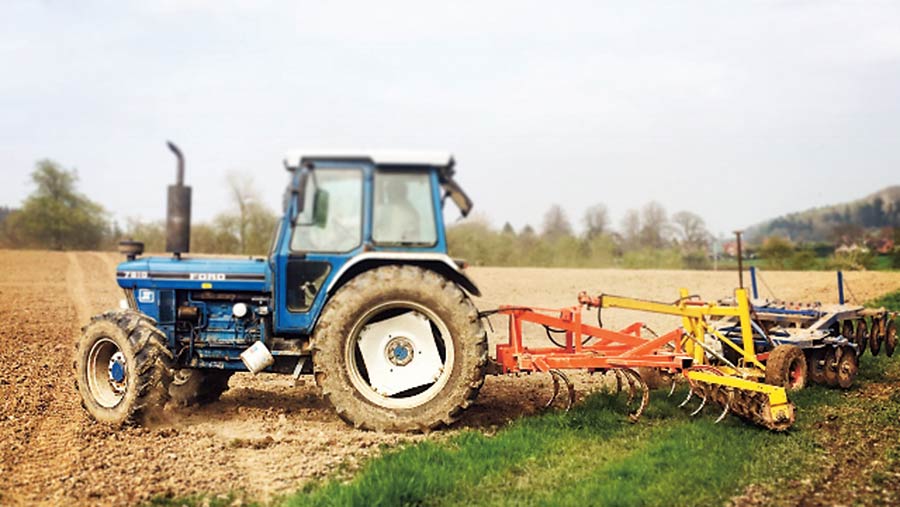
By attaching a single hydraulic ram between the drawbar and the top of his trailed linkage he’s also able to tilt the frame forward, lifting the discs out of the ground independently.
To finish the job off he fitted a following harrow on the rear, which he picked up from a local dealer for £50. Crucially, the cultivator and discs can still be quickly uncoupled and used independently.
He built the outfit last winter using mainly recycled parts and a set of second-hand discs that had seized bearings. The whole thing cost less than £1,000.
Mr Esp pulls the rig with his 1989 Ford 7810, which develops about 90hp.
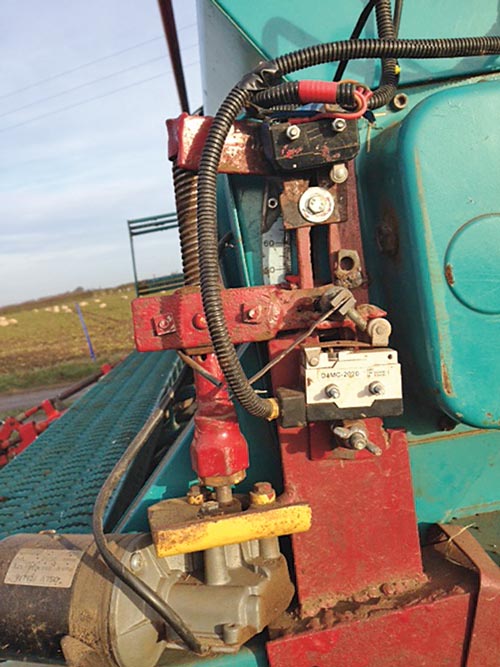
Peter Richardson’s variable-rate seed drill
Keen to get into variable-rate seeding without having to shell out a fortune, Lincolnshire farmer Peter Richardson decided to modify his Sulky combination drill.
He started by taking an electric reel speed adjuster off a New Holland combine and grafted it onto the slider that controls the drill’s seeding rate.
Via a pair of buttons he can now activate the motor, causing the seed rate adjuster to move up or down.
This gives him a variation of up to 20%, which he can tweak on the move depending on the condition of the seed-bed.
The in-cab control box has one button for up and one for down, plus a variation knob for reducing the speed of movement.
This is because the combine reel speed adjuster is a little too powerful for the small lever movement it’s now doing.
Mr Richardson did most of the work himself, but enlisted the help of a local auto-electrical engineer to put the wiring loom together.
The modification cost less than £200 and has been in use for the past three seasons.
Paul Apps’ chemical transporter
Paul Apps fabricated this neat front-mounted chemical transporter to make spraying on outlying blocks of land more efficient.
The box will comfortably hold 24 20-litre boxes of chemical – more than enough for a full day’s spraying – and has an opening lid and two front doors for easy access.
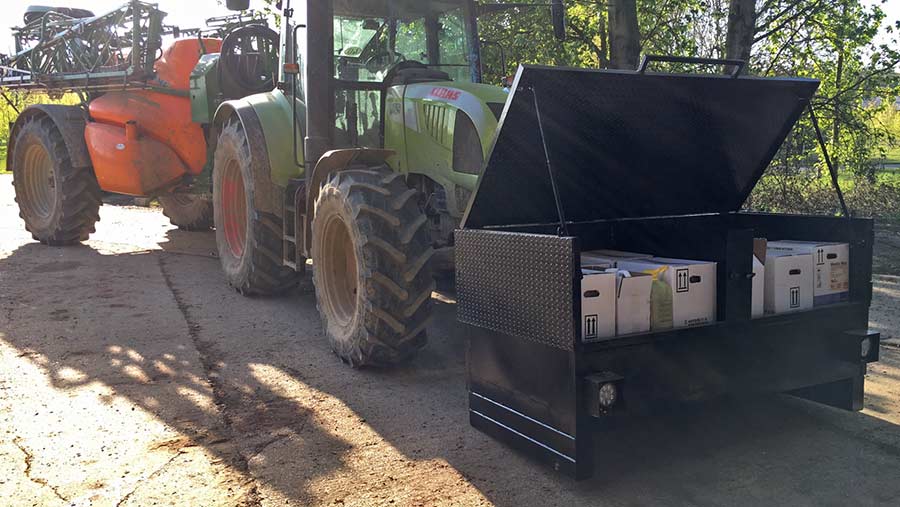
It’s also bunded in case of a leak and has a lock to prevent anyone gaining access. Mr Apps transports the container on the front of his Claas Arion spraying tractor and drops it at one of his remote water tanks, creating a temporary filling area.
At the end of the day he can then load up his rinsed empty containers, hook the unit back on and head off to the next job.
Winners of the Inventions Competition 2019
Simple category
- Winner: Jim Clay
- Second place: Albert O’Neill
- Third place: Jim Moody
Intermediate category
- Winner: John Stephens
- Second place: Robert Hooper
- Third place: George McMullan
Complex category
- Winner: Stephen McGuffie
- Second place: Harry Wiseman
- Third place: Rob and Dave Gash

